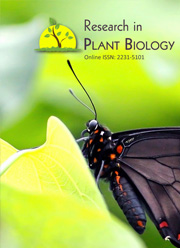An assessment of heavy metal remediation potential of Lawsonia inermis L. from iron ore tailings
Keywords:
Iron ore tailings (IOT), Catalase (CAT), Peroxidase (POD), Superoxide Dismutase (SOD, L.inermisAbstract
ÂÂ
ÂÂ
The present study aimed at studying the growth and physiological response of L. inermis on iron ore tailings. Pot experiments were conducted to investigate the effect of iron ore tailings both individually as well as in combination with soil (at different proportions) on the growth, pigment production as well as accumulation and translocation of various heavy metals from the tailings. The results suggested a decrease in the growth and chlorophyll content but increase in the carotenoids as well as metal accumulation capacity of L.inermis with increasing proportion of tailings in the soil. Furthermore, an increase in antioxidant (Carotenoids, Catalase, Peroxidase and Super Oxide Dismutase) activities in plants grown on tailings as compared to control was observed which suggests plant efficiency to overcome any stress generated due to excess of heavy metals. The order of accumulation of various heavy metals in the plant parts was observed to be Cr>Cu>Fe> Zn> Pb>Ni. However, the hundred percent survival rates of all the plants in all the treatments suggest its efficiency to survive metal stress. Thus the plant can be used for the reclamation of moderately contaminate areas.
ÂÂ



 .
. 